Today, in our lab, we are going to abuse an affordable slider phone: the Nokia X3. The specifications look like nothing to be excited about: a 3.2 megapixel camera which lacks LED flash, a microSD card slot on the left side of the phone and some other features that you usually find in any mobile phone.
The retail package of the Nokia X3 is shown on picture 1. In the box, as well as the phone itself there is charger, a microUSB cable and a headset (Pic. 2). The shortish microUSB cable isn’t comfortable to use. It also goes with some other most recent Nokia handsets.
The X3 has a refined design. The back panel and the sides of the device are white, the front panel is black (Pic. 3, 4). The back cover clings tightly to the phone and you’re likely to need some experience to remove it. The front panel comprises the three additional dedicated music keys. The small screen makes the phone look cheap. The viewing angles are atrocious and your eyes are likely to feel tired and fatigued. We already performed the tests of the cell phones with such displays: the Samsung C3300K Champ and the Nokia C5.
In spite of all the disadvantages, the Nokia X3 looks robust. Read further to know the results of the stress tests.
Результаты
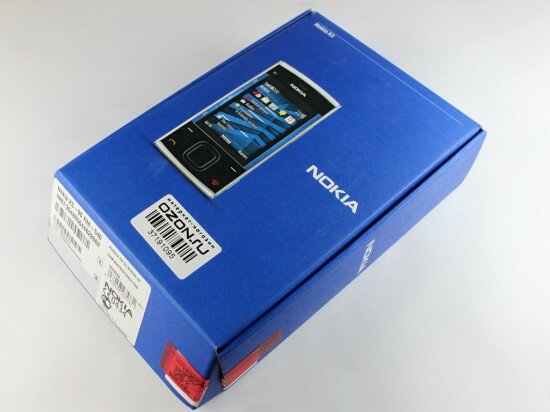
Pic. 1. The box
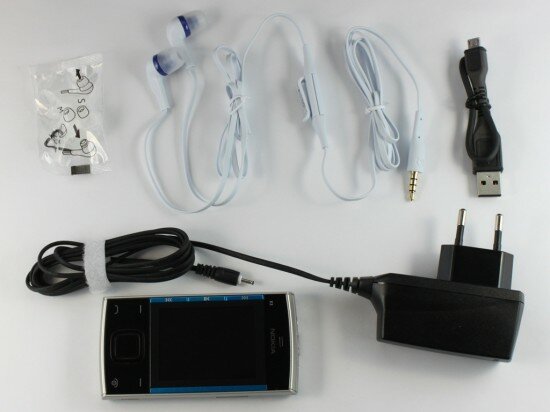
Pic. 2. The retail package
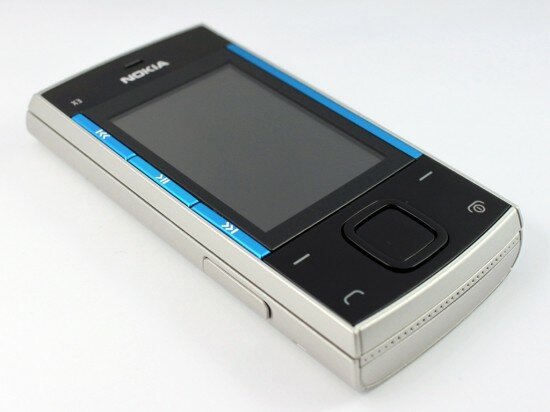
Pic. 3. The front panel of the Nokia X3
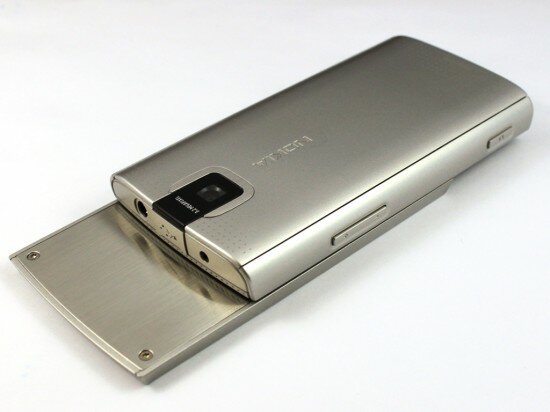
Pic. 4. The back panel of the Nokia X3
1. Nokia X3 stress tests. Stage 1 — Light shocks
1.1 Drop test
No matter how careful you are, you will bump your cell phone sooner or later. Your handset may accidentally fall on a soft carpet or on a hard floor – you never know.
We successively dropped the Nokia X3 on the carpet (video 1) with each face, edge, and corner from 1 m (3,28 ft) and from 30 cm (11,8 inches) on the ceramic tile (video 2). The drops from these distances didn’t cause any visible harm. The back cover was neither removed nor opened.
Video 1. Drops on the carpet from 1 m (3.2 ft)
The grade is 20 (with 30 being the highest possible grade)
Video 2. Drops on the tile from 30 cm (11.8 inches)
The grade is 30 (with 30 being the highest possible grade)
1.2 Squeeze test
Don’t worry, we didn’t run the Nokia X3 with a car. We performed the other test. We applied a 3 kg (6.6 lbs) pressure from a wooden bar above the phone. The X3 stayed functional. The two parts of the chassis rubbed against each other as fine as before the test.
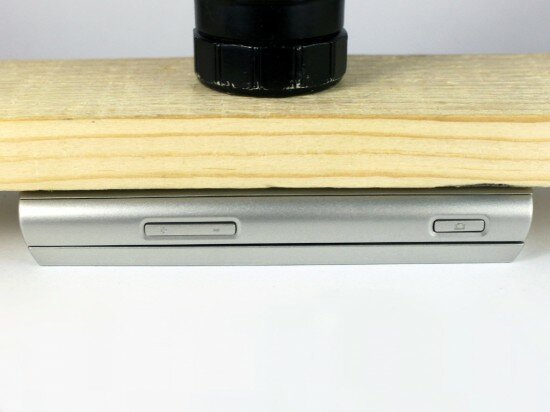
Pic. 5. The Nokia X3 under the wooden bar
The grade is 24 (with 24 being the highest possible grade)
1.3 Bend test
One more way to stress test a cell phone is to bend it. We put the Nokia X3 on the two planks so that each edge of the gadget lies on a single plank. Then we hitched a string with 1 kg load (2.2 lbs) on top of the device. The X3 sustained no sign of bend and stayed functional.
The grade is 24 (with 24 being the highest possible grade)
1.4 Durability
The appearance of a cell phone after a long period of everyday use depends not only on the treatment but also on the quality of the material (its durability) of which the phone is made.
We placed the Nokia X3 inside a drum together with keys, pennies, and plastic balls. The drum viciously rotated the gadget for 5 min. in order to make it look as old as possible (video 3).
After the test, we examined the device. We have to admit that it looked fine. However, we had to lower the grade for the phone in this test because there were some small scuffs on the corners (Pic. 6). The screen and the D-pad sustained minor scuffs, almost invisible for a naked eye (Pic. 7). The other parts of the phone showed no damage.
Video 3. Drum rotation
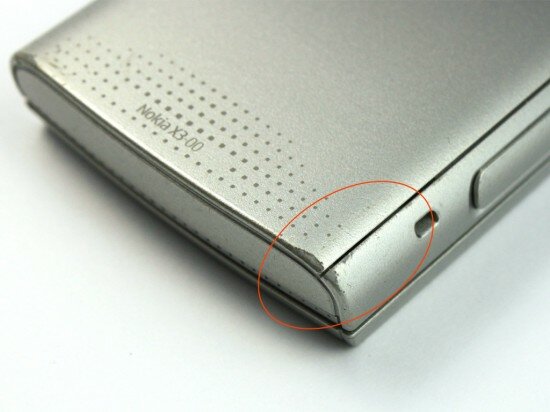
Pic. 6. Scuffs on the corners
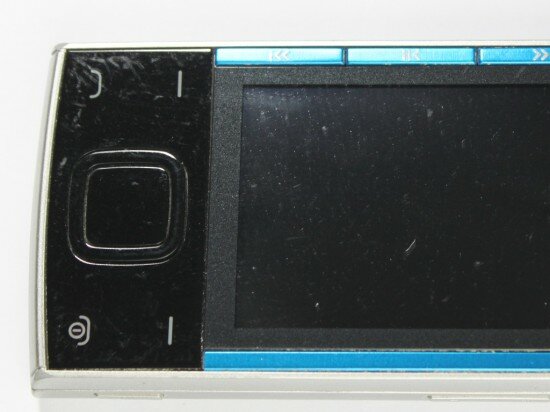
Pic. 7. The screen and the D-pad after the test
The grade is 10 (with 15 being the highest possible grade)
1.5 Scratch test
Have you ever happened to scratch your new cell phone after a few days of use? The scratches on the screen disappoint most of all.
We tested the Nokia X3’s scratch resistance. We fixed a nail to the plank that put 100 g (0.22 lbs) pressure upon the phone.
As a result, the screen showed a minor scratch, visible only when the backlight was on (video 4). We saw no scratch on the body of the phone.
Video 4. Screen scratching
The screen gets 15 points (with 15 being the highest possible grade)
The back panel gets 15 points (with 15 being the highest possible grade)
1.6 High temperature
In this test, we checked how the Nokia X3 can survive heat. Actually, we placed the phone in a metallic container 5 cm from the electric bulb (40 Wt). The bulb heated the phone for 3 min. (video 5). The gadget survived such test and performed perfectly afterwards. However, the temperature of the phone rose to 79 °C (174.2 °F). The device lacks steel components and steel absorbs heat. That’s why the X3 became so hot.
The grade is 12 (with 12 being the highest possible grade)
1.7 Dust test
To some extent, all electronic gadgets are water and dust resistant. Some of them are better, some of them are worse. Speaking of cell phones, dust and dirt can be more dangerous than water.
In order to check the Nokia X3’s dust resistance, we did the following: we took an enclosed tray containing dust and threw the phone inside it. Then, we made it vibrate viciously for 2 min. After the test, we examined the gadget.
As a result, much dust seeped through the back cover (Pic. 8). The grains of sand penetrated between the two parts of the chassis. Some of them stuck to the keyboard (Pic. 9). The sections of the slider rubbed against each other with squeaks due to the dirty rails. We had to apply force to slide the phone. Lots of dust penetrated the microUSB data port. We again proved that the plastic caps that cover the USB ports are absolutely useless. They would better put the cap on the audio jack which is more difficult to clean because it is deeper than the data port.
The D-pad is a major disappointment with the Nokia X3 hardware. The soft keys and the Call and End keys became stiff and worked without clicks. We had to apply some force to press them.
After the test, we cleaned the Nokia X3. Soon the phone started to slide fine again. However, it took us a lot of time to clean the D-pad because too many grains of dust accumulated under it.

Pic. 8. Dust in the battery slot
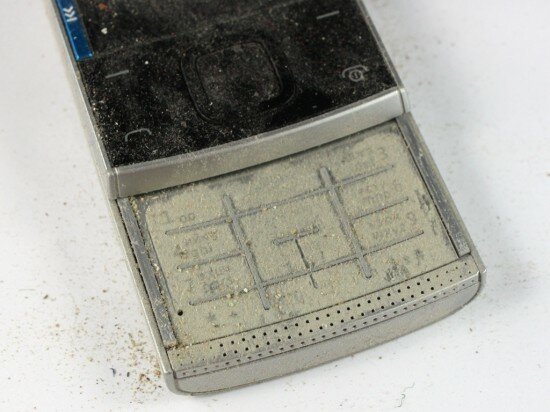
Pic. 9. The D-pad and the keyboard after the test
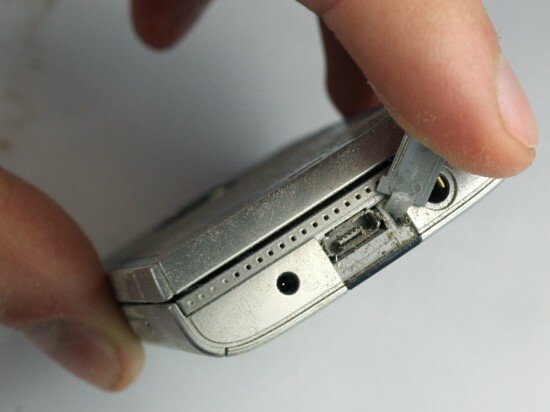
Pic. 10. Dust in the microUSB data port
The grade is 8 (with 12 being the highest possible grade)
1.8 Call reception
Whatever they say, the main function of any cell phone is to make and receive calls. In this test, we checked the Nokia X3’s signal strength. We placed the handset inside a box. Then we foiled the box (the foil served as a shield) and made a 40 x 45 mm (1.57 x 1.77 inches) hole in it (video 5). Then we started to call the X3. There were 1 – 3 bars in the indicator of signal strength. The phone received all incoming calls with no problem.
Video 5. Call reception test
The grade is 15 (with 15 being the highest possible grade)
After the 1st stage of the stress test, the Nokia X3 got 183 (with 192 being the highest possible grade)
2. Nokia X3 stress tests. Stage 2 — Tough conditions
2.1 Drop test
In the previous test, we dropped the Nokia X3 from the small distances. This time, we increased the height of the drop on the carpet to 1.5 m (4.9 ft) and to 50 cm (1.64 ft) on the tile to simulate the fall from a stool.
The Nokia X3 stayed absolutely functional and performed fine. The bumps didn’t make the phone slide. The back cover was removed only once (after one of the drops on the tile).
Video 6. Drops on the carpet from 1.5 m (4.9 ft)
The grade is 30 (with 30 being the highest possible grade)
Video 7. Drops on the tile 50 cm (1.64 ft)
The grade is 30 (with 30 being the highest possible grade)
2.2 Squeeze test
In this test, we applied 10 kg (22 lbs) pressure from a wooden bar above the Nokia X3. When we placed the wooden bar on the phone, we heard an unpleasant noise produced by the grains of sand that stuck between the two parts of the chassis. It didn’t cause any problem to the gadget.
The grade is 24 (with 24 being the highest possible grade)
2.3 Bend test
We made the bend test tougher. The weight of the load was increased to 5 kg (11 lbs). The Nokia X3 showed a sign of bend (Pic. 11). This is strange because two parts of the chassis should make slider phones twice as rigid as candy bars. Despite the visible bend, the X3 showed no damage and performed pretty fine after the test.
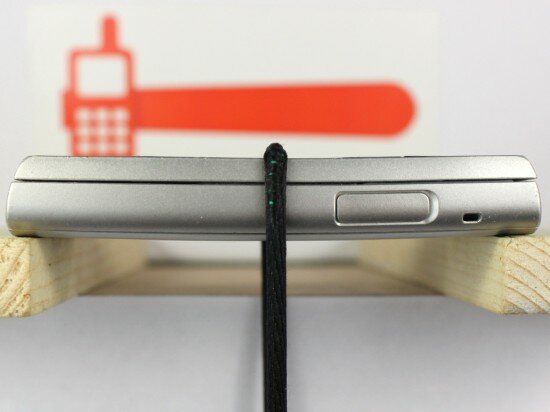
Pic. 11. Bend caused by 5 kg (11 lbs) weight
The grade is 24 (with 24 being the highest possible grade)
2.4 Durability
This time, the drum rotated the Nokia X3 for 10 min. The appearance of the phone didn’t change much for the worse: just a few more scuffs on the back cover (Pic. 12), a few more tiny scratches on the screen and on the D-pad (Pic. 13).
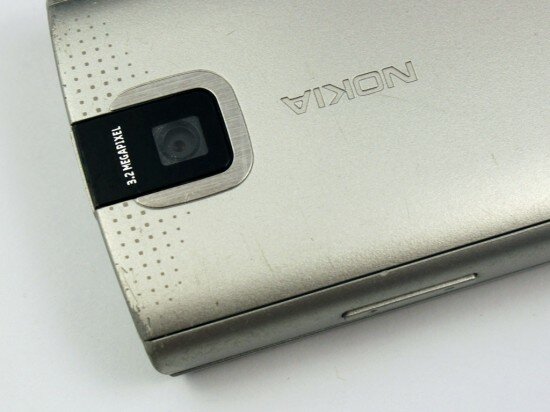
Pic. 12. Scuffs on the back cover
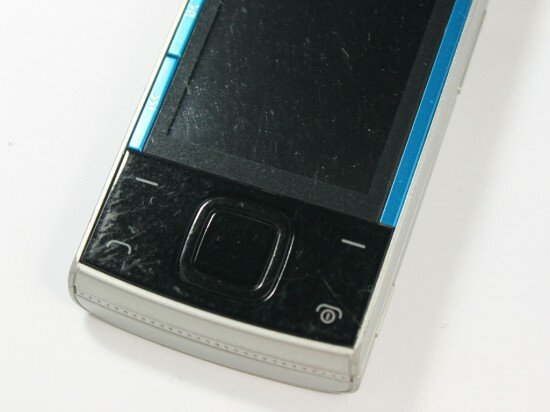
Pic. 13. Scratches on the screen and on the D-pad
The grade is 15 (with 15 being the highest possible grade)
2.5 Scratch test
In this test, we scratched the Nokia X3 at the force of 300 g (0.66 lbs) (video 8, 9). When the backlight was off, the scratch on the screen seemed tiny. In the bright lights it became quite visible. But when we switched on the backlight, the scratch was so big that it ruined the picture on the screen. The back cover showed only a minor scratch.
Video 8. Screen scratching (the force is 300 g (0.66 lbs))
Video 9. Back cover scratching (the force is 300 g (0.66 lbs))
The screen gets 10 points (with 15 being the highest possible grade)
The back cover gets 15 points (with 15 being the highest possible grade)
2.6 Freeze test
Those people who live in the countries with severe climate are not afraid of frosty winters. But we can’t say the same about electronic gadgets. Cell phone displays can malfunction in extremely cold weather and cell batteries deplete quicker than usual (that is, their capacity goes down much faster compared to moderate temperatures).
In order to check the performance of the Nokia X3 in such environments, we did the following: we took a box filled with ice cubes, placed the phone in it, and then placed the box in a freezer for 2 hours. The phone was left in speaking mode during that time. The temperature in the freezer was approximately -15 – -20 °C (+5 – -4 °F).
When we took the phone out of the freezer, everything seemed fine (video 10): the battery was full, the keys were not stiff at all. The display malfunctioned only a little bit. But when we tried to make a call, the phone gave a warning that the battery was empty (the capacity of the battery went down to zero) and switched itself off. When we warmed the gadget, the battery became full again.
Video 10. Freeze test
The grade is 6 (with 18 being the highest possible grade)
2.7 High temperature
This time, the Nokia X3 spent 5 min. under the direct rays of the electric bulb which heated the phone to 92 °C (197.6 °F). Nevertheless, the device stayed functional, the display was fine and the plastic body didn’t melt at all.
Video 11. High temperature test
The grade is 12 (with 12 being the highest possible grade)
2.8 Immersion in water
You are unlikely to drop your cell phone in water. But one day you can be caught in the rain with the phone in your hands or you can accidentally pour some water onto your handset, can’t you?
In this test, we dunked the Nokia X3 under water for 1 sec. (video 12). The phone successfully passed this test. There was almost no evidence of water in the battery slot and in the connectors (Pic. 14).
We took out the battery and dried the phone. It performed fine afterwards.
Video 12. Immersion in water for 1 sec

Pic. 14. The connectors stayed almost dry
The grade is 30 (with 30 being the highest possible grade)
2.9 Dust test
We increased the time of this test to 5 min. As a result, we saw much more dirt in the Nokia X3’s connectors (Pic. 15). The grains of dust on the rails of the slider inflicted the scuffs on the border of the alphanumeric keyboard (Pic. 16). The D-pad was stiff. It worked only when we pressed it heavily. The keys started to perform fine again after the third stage of the durability test.

Pic. 15. Dust in the connectors
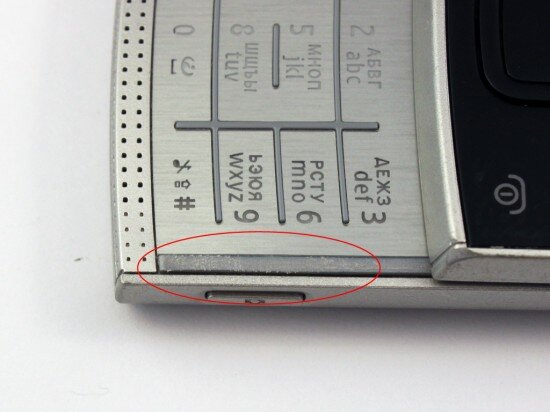
Pic. 16. Scuffs on the border of the keypad
The grade is 10 (with 15 being the highest possible grade)
2.10 Call reception
The smaller the hole, the weaker the reception is. We put the Nokia X3 in the box with 20 x 20 mm (0.787 x 0.787 inches) hole (video 13). During the test, the indicator didn’t show more than 3 bars. The phone received all incoming calls with no problem.
Video 13. Call reception test
The grade is 15 (with 15 being the highest possible grade)
After the 2nd stage of the stress tests, the Nokia X3 got 219 (with 240 being the highest possible grade)
3. Nokia X3 stress tests. Stage 3 — The toughest conditions
3.1 Drop test
In the last stage of this test, we increased the distance of the drops on the carpet to 2 m (6.56 ft) and to 1 m (3.28 ft) on the tile (video 14, 15).
We didn’t see the show in which the Nokia X3 was broken apart. During the test, the back cover opened several times. After the drops on the tile, the two parts of the chassis became loose. However, it didn’t cause any problems.
Video 14. Drops on the carpet from 2 m (6.56 ft)
Video 15. Drops on the tile from 1 m (3.28 ft)
The grade for the drops on the carpet is 30 (with 30 being the highest possible grade)
The grade for the drops on the tile is 30 (with 30 being the highest possible grade)
3.2 Squeeze test
20 kg (44 lbs) was the maximum pressure that we applied on the device. As a result, the gap between the two parts of the chassis became smaller. But after the test, the sections of the slider rubbed pretty fine against each other.
The grade is 24 (with 24 being the highest possible grade)
3.3 Bend test
We applied 10 kg (22 lbs) weight in our attempt to bend the Nokia X3 (Pic. 17). The bend was very big and we feared that the display or the circuit board would be cracked by this weight. But the phone survived and even restored its original shape after the test.
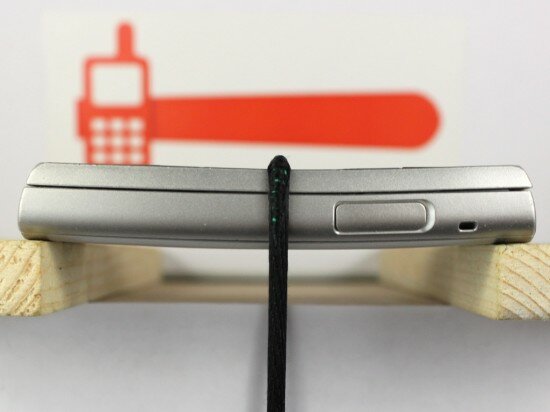
Pic. 17. Bend caused by 10 kg (22 lbs) weight
The grade is 24 (with 24 being the highest possible grade)
3.4 Durability
This time, the Nokia X3 spent 20 min. in the drum. As a result, we saw a lot of small scratches on the sides of the phone (Pic. 18). More scuffs appeared on the corners. There were also many scuffs on the D-pad. The scratches ruined the quality of the picture on the screen (Pic. 19).

Pic. 18. The bottom side of the Nokia X3
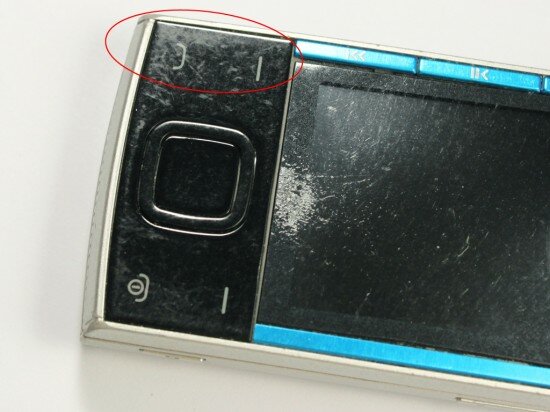
Pic. 19. The screen and on the D-pad
The grade is 10 (with 15 being the highest possible grade)
3.5 Scratch test
We applied the maximum force of scratches: 600 g (1.322 lbs). This inflicted a deep scratch on the screen (Pic. 20, video 16). By the way, the other two scratches made by the nail were visible on the white background of the display (Pic. 21). This time, the back cover showed a big deep scratch (Pic. 22, video 17).
Video 16. Screen scratching
Video 17. Back cover scratching
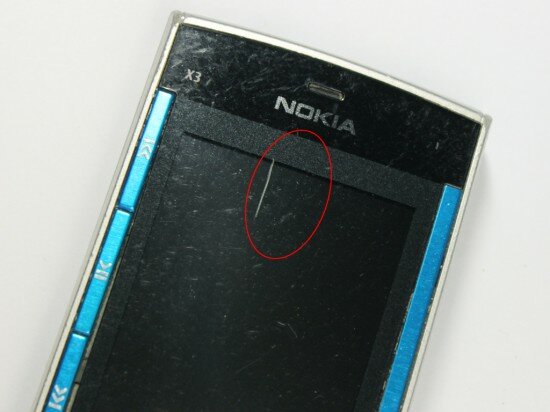
Pic. 20. Scratches on the screen
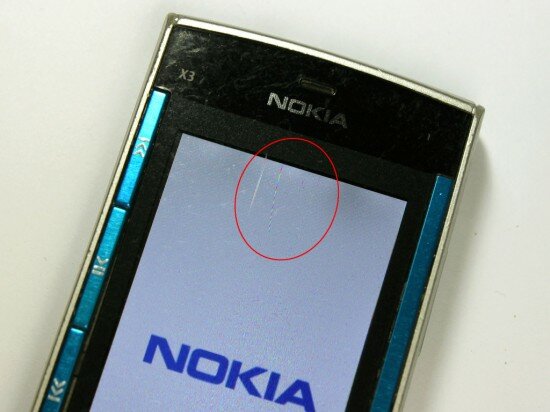
Pic. 21. This is how the quality of the picture was ruined
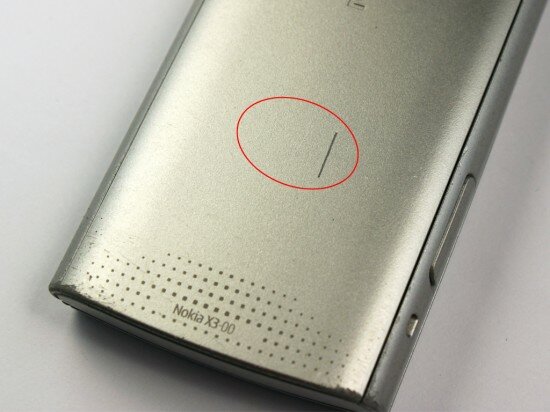
Pic. 22. Scratches on the back cover
10 points for the screen (with 15 being the highest possible grade) for the screen
10 points for the back cover (with 15 being the highest possible grade) for the back cover
3.6 High temperature
We left the Nokia X3 under the direct rays of the electric bulb for 10 min. (video 18). The phone showed worse results, compared to the previous heat tests. The bulb heated the gadget to 112 °C (233.6 °F) and melted the protective screen glass (Pic. 23) and the D-pad. When the temperature of the X3 became normal, the phone performed with no problem. The device showed only visible harm.
Video 18. High temperature test
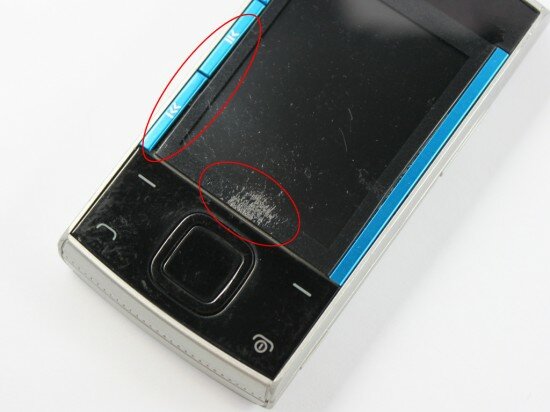
Pic. 23. Damage of the screen glass
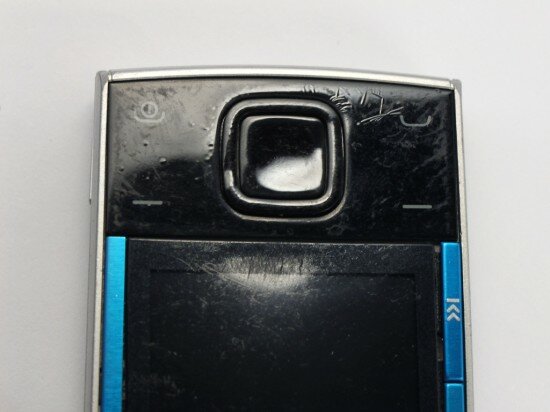
Pic. 24. Damage of the D-pad
The grade is 8 (with 12 being the highest possible grade)
3.7 Immersion in water
In this test, we dunked the Nokia X3 under water for 20 sec. (video 19). The result was the same as in the previous water test: the phone stayed functional. However, the ring sound became a little bit lower. More water penetrated under the back cover. We even saw the evidence of water under the battery. We dried the gadget with warm air for an hour and the it performed fine afterwards.
Video 19. Immersion in water for 20 sec
The grade is 30 (with 30 being the highest possible grade)
3.8 Immersion in beer
What else (except water) can people pour onto their cell phones? Let it be beer.
In this test, we dunked the Nokia X3 under beer for 10 sec. (video 20). The phone identified the headphones the same moment when the beer penetrated the audio jack. After the test, the speakers produced no sound at all. The microphone also didn’t work. The beer penetrated deeper than water. The battery slot and the circuit board got wet. We took the battery out immediately. Then, we washed and dried the phone. Fortunately, it stayed functional.
Video 20. Immersion in beer for 10 sec
The grade is 9 (with 9 being the highest possible grade)
3.9 Dust test
We increased the time of this experiment to 10 min. In general, the results were the same as in the previous dust tests. The main difference was the D-pad. It didn’t work for some time after the previous dust test. Now the D-pad didn’t work at all. We had to disassemble the Nokia X3 and clean the D-pad from the inside in order to solve the problem.
The rails of the slider were damaged. The feel of plastic-sliding-over-plastic was unpleasant. Some grains of dust penetrated even under the camera lens. The sound of the speakers became worse. They started to wheeze.
The grade is 4 (with 12 being the highest possible grade)
3.10 The keypad
Speaking of the Nokia X3’s hardware, we should say that the D-pad, the music keys, the volume rocker and the camera key are comfortable to use. However, the alphanumeric keyboard is the other sort of thing. You may accidentally press the two keys instead of one at the same time not only because they are tiny, but also because the vertical and horizontal ridges don’t separate the keys properly.
The D-pad is not dust resistant at all. It became stiff and didn’t even work when the grains of dust penetrated under it. But in cold weather, all the keys performed pretty fine.
The grade is 5 (with 15 being the highest possible grade)
3.11 Call reception
We decreased the size of the hole in the shielded box to 15 x 15 mm (0.59 x 0.59 inches). The indicator of signal strength displayed only 1 bar. The handset received all incoming calls.
Video 21. Call reception test
The grade is 15 (with 15 being the highest possible grade)
3.12 Short circuit and overcharge
At first we wanted to know what would happen to the battery charger of the Nokia X3 after a short circuit that may happen any time, for example, if some tiny pieces of metal penetrate the charger jack. A short circuit may also happen if the charger jack is broken.
So we made a short circuit of the power supply terminals with the help of the forceps for 1 sec. (video 22). It did not break the battery charger. The charger stayed functional.
Video 22. Short circuit of the battery charger
Do you know that there is a board inside a cell phone battery that protects an electrochemical cell from a short circuit and over-charging? We decided to check the charging circuitry within the Nokia X3. Actually, we made a short circuit of the two terminals (with symbols ”+” and ”-”) with the help of the forceps for 1 sec. (video 23).
Usually, new cell phone batteries are able to withstand short circuits. Their capacities don’t go down. The Nokia X3’s battery is not an exception. It successfully survived the short circuit.
Video 23. Short circuit of the battery
A battery charger can be broken or lost. In this case, you’ll have to buy a new one. And your new battery charger may be a little bit different from the previous one. For example, it can put much more or much less energy into your cell battery which can lead to unpredictable results.
We checked the reaction of the Nokia X3 to the increase and decrease of charge current. In order to perform this test, we plugged the battery charger in the PSU (video 24).
The increase of charge current to 8 V didn’t stop the charging. But the energy consumption of the battery rose to 800 mА. Putting so much energy into the battery regularly decreases its lifetime and damages your mobile phone. When we decreased the charge current to 4.1 V, the phone gave a warning about the power cut.
Video 24. Increase and decrease of charge current
Finally, we performed the most dangerous test for the Nokia X3’s electronic components. We took the battery out and plugged the PSU in the phone and increased the voltage twice as much, compared to the battery’s voltage (video 25).
This is not the first case when the batteries of the recent Nokia handsets become fully discharged, despite the average voltage. The result depends on the cell phone itself. When we plugged the PSU in the HTC Desire, it refused to switch on at all.
The Nokia X3 is able to accept high voltage with no problem. The energy consumption rose insignificantly in this test.
Video 25. Increase in voltage
For the ability to withstand short circuits the battery charger gets 15 (with 15 being the highest possible grade)
For the ability to withstand short circuits the battery gets 15 (with 15 being the highest possible grade)
For the ability to survive the increase and decrease of charge current the Nokia X3 gets 10 (with 15 being the highest possible grade)
For the ability to survive the high voltage the Nokia X3 gets 15 (with 15 being the highest possible grade)
3.13 Disassembling
After all the tests, we disassembled the Nokia X3 (Рiс. 25). By the way, it’s easy to take apart the slider phones and the X3 is not an exception.
There are two polyphonic speakers in the phone: one at the bottom, the other at the top. Most of the elements on the circuit board are protected by non-removable metallic shields (Рiс. 26). The keypad is attached to the front side of the circuit board (Рiс. 27) and this is not the best solution because it may badly influence the circuit board. The presence of the loop is one more disappointment because this is the weakest component of the phone. Mobile phones with this form factor (slider phones) often need to be repaired mostly because of the loop damaging. It’s very difficult to find a new loop for the Nokia X3 because it comprises the music keys, the D-pad and some other components. So it’s very expensive to replace this loop. Taking into consideration a great number of non-removable elements on the circuit board, we should say that the Nokia engineers didn’t care much about the maintainability of the X3.

Pic. 25. The Nokia X3 disassembled
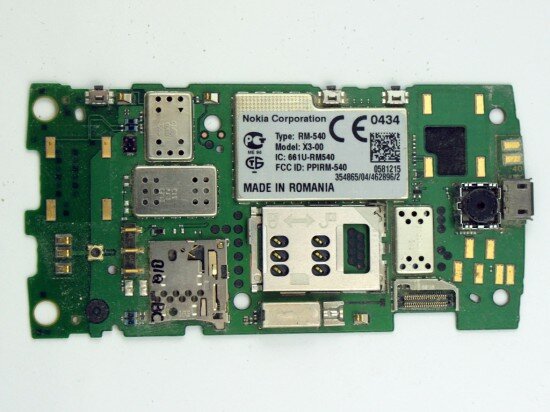
Pic. 26. The Nokia X3’s circuit board

Pic. 27. The front side of the Nokia X3’s circuit board
The grade is 10 (with 15 being the highest possible grade)
After the 3rd stage of the stress tests, the Nokia X3 got 289 points (with 351 being the highest possible grade)
When we tested the Nokia X3, we noticed some peculiarities that made this cell phone different from the others. Sometimes the X3 outperformed the other gadgets, sometimes it showed poor results.
Let’s start with the advantages of this device. The phone survived the drops on the carpet and on the tile with no problem. As for the design, this model moves away from the rounded corners of most recent Nokia handsets, and goes for bold, straight lines. That’s why a lot of small scuffs appeared on the corners during the durability tests and we had to lower the grade for the X3. Moreover, the protective screen glass is not of the best quality. However, the chassis stayed attractive and it deserves our praise. The D-pad is the Achilles’ heel of the Nokia X3. This showed up in the dust tests. If you work in dirty environments or if you prefer outdoor activities we don’t recommend you to buy the Nokia X3. Moreover, this phone is likely to malfunction in cold weather and can be damaged by the sun rays if you leave it in the sun for a long time.
That’s all about the Nokia X3. Overall, this device passed our stress tests and showed the results that we expected to see.
Here’s how the gadget looks like after all the tests (Pic. 28, 29, video 26).
Video 26. Here’s how the gadget looks like after all the tests

Pic. 28. Here's how the front panel of the phone looks like after all the tests
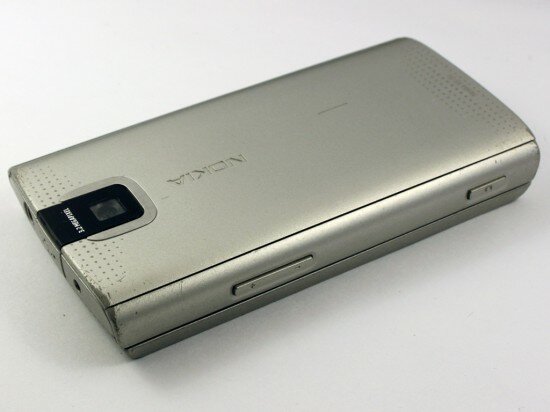
Pic. 29. Here's how the back panel of the phone looks like after all the tests

 Russian version
Russian version
Comments (3)
wao great. that’s a wonderfull tweak Nokia X3 plz keep going about that. thanx
I like your website. Can you please expanded to laptop?
How about doing a stress test on the LG optimus one P500? This phone seems quite popular now as as its a great budget android phone with all connectivity functionalities. I’m sure users of this phone will be interested to see how it performs…